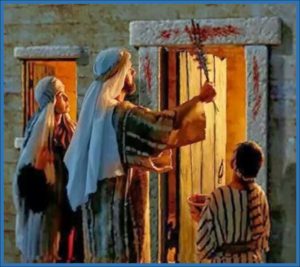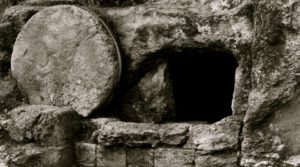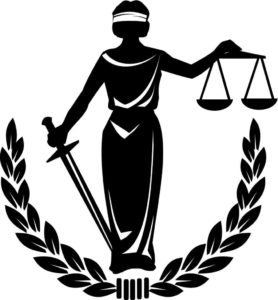Is Passover an Appointed Time for the Crucifixion?
Crucifixion of Jesus of Nazareth didn’t happen on just any day of the year…the timing is simply too hard to ignore. His execution was either a 1-in-365 happenstance incident or, perhaps, an appointed time of divine design.
Nisan 15th – Jesus was crucified on the first day of the Jewish Passover. Merriam-Webster defines a sacrifice as “an act of offering to a deity something precious.”
Passover commenced at sunset, the beginning of a Jewish day, with the Feast of Unleavened Bread. The meal was intended to commemorate the time when the sacrifice of an innocent lamb had been required of God for salvation from the angel of death in Egypt.
A basic understanding of an appointed time helps to determine whether the timing of the crucifixion was merely a coincidence or more than that. Clues are found in the story of how the Hebrew Law came to be given by God at Mt. Sinai.
_ _ _ _ _
God’s booming voice coming from the burning bush at the base of Mt. Sinai instructed Moses to return to Egypt after a 40-year exile. Along with his brother Aaron, they were to confront the mighty Pharaoh of Egypt with a clear and succinct message:
Ex 5:1 …”Thus says the LORD God of Israel: ‘Let My people go, that they may hold a feast to Me in the wilderness.’”(NKJV)
Initially, Pharaoh was not willing to give up his slave labor force, but he paid a big price. Suffering through several plagues, Egypt’s ruler was finally wanting to stop the misery and commanded, “‘Go, serve the Lord your God.”
Realizing he was about to make a big mistake if he let all of his Hebrew slaves leave, Pharaoh asked, “Exactly who is going with you?” On the other hand, if he only released the Hebrew men to go have this feast, he could hold their family’s hostage.[1]
Moses countered with an unexpected response that blunted Pharaoh’s scheme: “We will go with our young and our old, with our sons and our daughters, and with our sheep and our cattle we will go, because we are to hold a pilgrim feast for the Lord.”[2]
‘No way!’ was the essence of Pharaoh’s response saying, “‘No! Go, you men only, and serve the Lord, for that is what you want,” then Moses and Aaron were driven out of Pharaoh’s presence.”[3] The 9th plague of deep darkness for three full days came next, but Pharaoh still did not relent.
A 10th plague was now coming to persuade Pharaoh to let the Hebrews go. This time it would include very personal consequences with more major financial impacts.
Livestock value to both the Egyptians and Hebrews was very significant, especially for the enslaved Hebrews. Sheep were the source of clothing, food and milk, even as pets. For a household to lose a single lamb meant losing a valuable commodity.
For the Egyptians, cattle were valued in much the same way as sheep. Cattle were part of the Egyptian religion and represented a status of wealth where losing a significant portion of livestock would have a disastrous affect.[4]
 Leading up to the horrible night of the 10th plague, God offered protection for the Hebrews if they followed a precise sacrificial ritual. Each family was to choose one of their unblemished lambs, sacrifice it, splash its blood on the door posts of their homes, and roast the lamb for a family feast at sunset.[5]
Leading up to the horrible night of the 10th plague, God offered protection for the Hebrews if they followed a precise sacrificial ritual. Each family was to choose one of their unblemished lambs, sacrifice it, splash its blood on the door posts of their homes, and roast the lamb for a family feast at sunset.[5]
At midnight, the angel of death passed over any home with the lamb’s blood splashed on the doorposts thereby sparing the of the Hebrew’s firstborn and their livestock. The 10th plague was devastating for the Egyptians – every firstborn died including the death of Pharoah’s own son breaking his resolve.
Salvation from the plague of death set the stage for what would become Israel’s first legally mandated Feast of Unleavened observance. Passover was to be observed every year from that time forward:[6]
Ex 12:14 ‘So this day shall be to you a memorial; and you shall keep it as a feast to the LORD throughout your generations. You shall keep it as a feast by an everlasting ordinance.(NKJV)
A few weeks later, God handed down the Law to Moses atop Mt. Sinai. The Law defined the observance of three annual Festivals or Feasts and a permanent place to observe the Passover at its appointed time:
Lev. 23:4-7‘These are the feasts of the LORD, holy convocations which you shall proclaim at their appointed times.
‘On the fourteenth day of the first month at twilight is the LORD’S Passover.
‘And on the fifteenth day of the same month is the Feast of Unleavened Bread to the LORD; seven days you must eat unleavened bread.
‘On the first day you shall have a holy convocation; you shall do no customary work on it. (NKJV)
Centerpiece of the Passover commenced on Nisan 14 was the sacrifice of the paschal lamb eventually to permanently occur in the place God was yet to reveal.[7] Following at sunset, Nisan 15, was the Feast of Unleavened Bread featuring the roasted meat of the sacrificial lamb.
Passover was a week-long celebration yet the Festival was intended to be a solemn time in remembrance of God’s miraculous deliverance from slavery and tyranny. The Law’s definition for observing the Passover used similar terms as for the weekly Sabbath, each was called “a holy assembly” or “holy convocation.”[8]
Found to be innocent by the government rulers Tetrarch Herod and Procurator Pilate, at the urging of the Jewish leadership Jesus was crucified on the first day of Passover observed at its appointed time. Events surrounding the crucifixion of Jesus at the Passover were controlled solely by his archenemies – out of the control of Jesus, his Disciples or any alleged Christian conspirators.
Was the crucifixion of Jesus on Passover, Nisan 15, merely a coincidence or a divinely appointed time?
Updated August 28, 2024.
This work is licensed under a Creative Commons Attribution-NonCommercial-NoDerivatives 4.0 International License.
NKJV = New King James Version translation.
NET = NETBible translation
REFERENCES:
[1] NET.
[2] NET.
[3] Quotes from NET translation. Exodus 10[iv] Exodus 12.
[4] Benner, Jeff A. “Ancient Hebrew Livestock.” Ancient Hebrew Research Center. 2022. <https://www.ancient-hebrew.org/culture/ancient-hebrew-livestock.htm> Cownie, Emma. Emmafcpwnie.com. 2018. “Why cattle mattered in the Ancient World.” <https://emmafcownie.medium.com/why-cattle-mattered-in-the-ancient-world-4e27b1c37e58> “Cattle in the ancient world of the Bible” Women In The Bible. 2006. <https://womeninthebible.net/bible_daily_life/cattle_ancient_world/#:~:text=Cattle%20were%20an%20important%20status%20symbol.%20In%20biblical,as%20well%20as%20for%20ploughing%2C%20threshing%20and%20transport.> Broyles, Stephen. The Andreas Center. 2010. <https://www.andreascenter.org/Articles/Sheep%20and%20Goats.htm> “Sheep in History. Sheep101.info. 2021. <http://www.sheep101.info/history.html
[5] Mock, Robert. Destination Yisra’el. “The First Pesach in the Land of Egypt.” photo. 2017. <https://destination-yisrael.biblesearchers.com/destination-yisrael/2017/04/the-history-of-the-passover-in-the-days-of-the-nazarene.html>
[6] Exodus 12:27; Deuteronomy 16:1-8.
[7] Exodus 12; Deuteronomy 16; Leviticus 23. “Abib” and “Nisan.” Jewish Encyclopedia. 2011.
[8] Exodus 16:22-23, 29; 20:8-10; Leviticus 23:3. Babylonian Talmud. Rodkinson. 1918. Book 1, Tract Sabbath, Chapters 1-10; Book 2; Erubin, Pesachim, Book 3, Chapter IV, VI, VIII. <https://www.sacred-texts.com/jud/talmud.htm#t03> Edersheim, Alfred. The Life and Times of Jesus the Messiah. 1883. Book V, Chapter 15. pp 1382-1392 & pp 1393-1421. <http://philologos.org/__eb-lat/default.htm> Edersheim, Alfred. The Temple – Its Ministry and Services. Chapter 10. 1826 -1889. The NTSLibrary. 2016. <http://www.ntslibrary.com/PDF%20Books/The%20Temple%20by%20Alfred%20Edersheim.pdf> Jewish Encyclopedia. 2011. https://jewishencyclopedia.com/articles/6359-friday “Festivals,”“Holy Days,” “Passover,” ”Shabbat,” “Sabbath ” & “Sabbath and Sunday.” 2011. <http://www.jewishencyclopedia.com> “Shabbath.” <https://israelect.com/Come-and-Hear/shabbath/index.html; “Shabbat” and “Festivals. Jewish Encyclopedia. 2011. http://www.jewishencyclopedia.com


